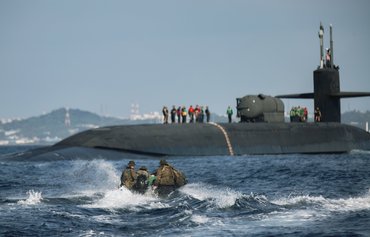The incredible ability of the US Navy's four Ohio-class nuclear-powered guided-missile submarines (SSGNs) to conceal themselves and deploy special forces into hostile environments, in addition to their overwhelming firepower, give the US military an increased depth of options in response to a potential crisis.
After the 1994 Nuclear Posture Review found that the United States needed only 14 of its 18 ballistic missile submarines (SSBNs) to meet its strategic force needs, the Navy transformed the other four into conventional land attack and special operations force (SOF) platforms.
The conversion of the four submarines was completed in 2007. They are the USS Ohio, Florida, Michigan and Georgia.
Each SSGN can carry up to 154 Tomahawk land-attack cruise missiles, the equivalent of what is typically deployed in a surface battle group.
The missiles are loaded in seven-shot Multiple-All-Up-Round Canisters (MACs) in up to 22 missile tubes. These tubes can also accommodate future payloads such as new types of missiles, unmanned aerial vehicles, and unmanned undersea vehicles.
The Tomahawk cruise missiles have a range of up to 1,600km and can carry a variety of warheads.
Some reports suggest these cruise missiles have a range of nearly 2,500km, enabling the SSGNs to hit high priority targets across the Middle East from the Red Sea or Gulf of Aden.
Special forces deployment
The SSGNs can also be configured to host up to 66 special forces personnel, such as US Navy SEALs.
As part of the conversion, the two forward-most missile tubes were permanently converted to lock-out chambers that allow clandestine insertion and retrieval of SOF personnel.
Each lock-out chamber can also accommodate a dry deck shelter, a removable module that can be attached to the SSGN to allow divers to leave and enter easily while the boat is submerged.
Tubes also allow special forces to stow equipment necessary to conduct dozens of tactical missions.
Each SSGN received the Common Submarine Radio Room and two High-Data-Rate antennas for significantly enhanced communication capabilities.
This equipment enables each submarine to serve as a forward-deployed, clandestine Small Combatant Joint Command Centre.
Just placing one Ohio-class submarine in the Arabian Sea would significantly enhance the US global posture and help achieve surprise in a conflict.
Like nuclear-powered attack submarines (SSNs), SSGNs can operate undetected near an adversary's homeland for extended periods. They can covertly insert SOF personnel and conduct surprise strike operations from close-in positions.
Unlike surface combatants, SSGNs carry no defensive missiles -- all payload tubes carry offensive weapons. That allows a single SSGN to cover strike packages for multiple surface combatants that can be assigned other duties when a cruise-missile sub is operating nearby.
Surfacing without warning
Ohio-class SSGNs move in near-silence even at 37km/hour and have the ability to emerge anywhere without warning.
"In July 2010, three SSGNs surfaced nearly simultaneously in Western Pacific and Indian Ocean waters, allegedly to signal US displeasure over Chinese missile tests in the East China Sea," the National Interest reported in 2021.
The USS Michigan surfaced off Pusan, South Korea; the USS Ohio in Subic Bay, the Philippines; and the USS Florida in Diego Garcia, Greg Torode reported for the South China Morning Post in 2010.
The message to China was clear.
"Between them, the three submarines can carry 462 Tomahawks, boosting by an estimated 60 percent-plus the potential Tomahawk strike force of the entire Japanese-based Seventh Fleet -- the core projection of US military power in East Asia," Torode reported.
The SSGNs' elusiveness and firepower undoubtedly play a pivotal role in deterring US adversaries since these submarines can be anywhere at any given time.
Washington sent a similar message to Moscow in 2022.
About a month prior to the Kremlin's February 2022 invasion of Ukraine, the US Navy Sixth Fleet made the location of the USS Georgia public off the coast of Cyprus.
The disclosure of the service's top-of-the-line submarines is rare, which suggests tensions were high enough for the United States to send a reminder to its adversaries that these formidable vessels exist at their doorsteps.

![The USS Ohio is shown during joint operations with US Marines off Okinawa, Japan, February 4, 2021. [US Navy]](/cnmi_am/images/2023/04/08/41473-ohio-600_384.jpg)







بد نیست
Reply2 Comment(s)
Nice
Reply2 Comment(s)